Q2 | Pastry
— Terms to Remember
Buttercream — Icing made by creaming butter until pale with icing sugar, vanilla, and milk.
Custard — Mixture used for filling consists of milk, sugar, eggs, and flavorings.
Filling — Any edible mixture used to fill pastries and other bakery products.
Fondant — Stiff and shiny icing which can be kneaded and rolled out to cover cakes and other bakery products.
Frosting — Sugary coating for cakes and other baked goods.
Ganache — An icing made of rich chocolate wither white or dark and cream.
Garnish — To decorate good with edible ornaments.
Glaze — A glossy edible coating applied to food.
Icing — A sweet mixture made primarily of sugar and often flavored used to coat baked products.
Meringue — Made of beaten egg whites and sugar commonly used in any baked products.
Pastry — Baked food products which contain items made from flour and fat pastes (e.g. pie crust).
made with a high protein fat to flour ratio, with very little liquid.
comes from the word paste, meaning a dough mixture of flour, liquid, and fat.
Pastry Cream — A mixture which contains starch as thickeners and eggs, resulting in a much thicker and more stable product.
— Ingredients for Making Pastries
Flour — The best flour used for pastry is all purpose- flour. Special pastry flour may be
used, specified in the recipe.
Shortening — Coats the particles of flour so water cannot penetrate them. In this way,
gluten strands are shortened, thus producing a good, flaky crumbly crust.
Shortening must be chilled before it used.
Forms of Shortening in Pastries:
lard or pork fat, which gives the “shortest” crust
butter, which is best in flavor and flakiness and it is used in puff pastry
margarine which gives a rich flavor
vegetable shortening, which has no characteristics, odor or taste of its own
vegetable oil, which is seldom used, because it does not produce a flaky crust
Liquid — Added to the flour and fat to bind the ingredients together and
convert them into pliable dough.
important to develop some gluten within the flour and to give structure and flakiness to the dough.
if an excessive amount of water is used, the crust will become tough due to an excessive amount of gluten development.
If not enough water is used, the crust will disintegrate.
Salt — It has some tenderizing and conditioning effect on the gluten. However, it
contributes mainly to flavor.
Must be dissolved in the liquid before being added in order to ensure even distribution.
— Different Types of Pastry
Cream Puffs — A light pastry filled with whipped or sweetened cream filling and often topped with chocolate.
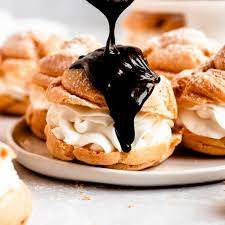
Puff Pastry — Rolled-in dough made with multiple layers that expand as the pastry bakes.
extremely, light, puffy, and flaky.

Danish Pastry — A pastry made from sweetened yeast dough with toppings like fruit, nuts, or cheese.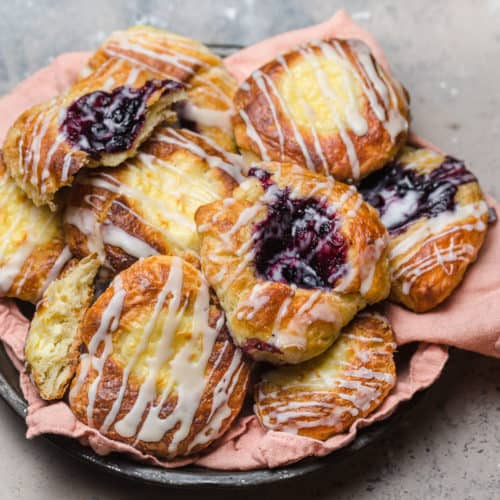
French Pastry — A rich pastry filled with custard or fruit.

Pie and Tart — Consists of the relatively thin pastry dough (pie), which when baked forms a crust (pastry shells) that holds the filling.
Croissants — A flaky raised-dough, which is rolled with butter to make layers then left to rise to create a light texture.
a fusion between a simple yeast-raise dough and puff pastry.
technically involved and requires an excellent deal of work.


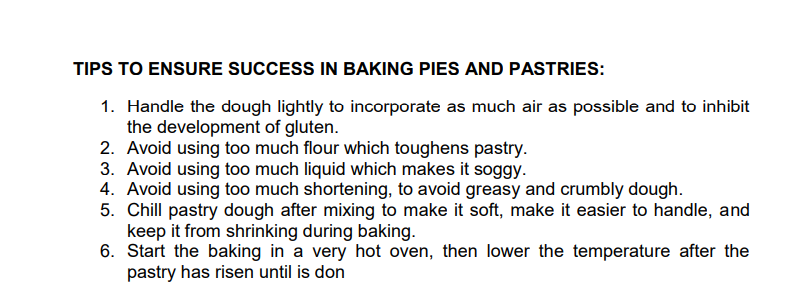
— Handling Ingredients
Flour:
Sift the flour to remove lumps.
Scoop to fill the measuring cup to overflow.
Do not shake and level off with a spatula.
Granulated Sugar:
Fill the measuring cup until it overflows.
Do not shake the cup, instead use spatula or the straight edge of the knife to level the sugar.
Brown Sugar:
Check if the sugar is lumpy before measuring.
Remove the dirt.
Pack into the measuring cup compactly and level using a spatula until the sugar follows the shape of the cup.
Baking Powder/Baking Soda:
Remove the lumps in the powder by stirring.
Dip the measuring spoon into the powder.
Level with the use of spatula of any straight edge tool.
Shortening (Solid Fats):
Fill the cup with the shortening while pressing until it’s full.
Level the fat with a knife or spatula.
Shortening (Liquid Fats);
Pour the liquid shortening in the glass measuring cup.
Check if it’s filled up to the measuring mark.
Do not lift the up when measuring.
Milk (Liquid Form):
Pour milk into the glass measuring cup and check if the measurement is correct by filling up the cup to the measuring mark.
Do not lift the cup while measuring.
Milk (Powdered):
Remove lumps and scoop lightly just to fill the measuring cup without shaking until its overflows.
Use the spatula or the straight fringe of the knife to level the measurement.
— Substitution of Ingredients



— Mixing Techniques
Stirring — The simplest method, because it involves mixing all the ingredients together with a utensil, usually a spoon in a circular motion.

Beating — The ingredients are moved vigorously in a back and forth, up and down, and around motion until smooth.
An electric mixer is usually used to beat the ingredients together.
Whisking — Air is incorporated into such foods as light whipping cream and egg whites through very vigorous mixing, usually with an electrical mixer or whisk.
Rolling — To flatten dough out into a sheet in preparation to shaping to various forms.
Laminating — Fat is repeatedly folded into the dough.
Creaming — A process where fat and sugar are beaten together until they take on a light, airy texture.
Kneading — Working with the dough using the heel of the hands, accompanied by pressing, stretching, and folding in order to develop its gluten.
Cut in or Cutting In — The process of distributing solid fat in dry ingredients.
— Baking Techniques
Preparing Baking Dishes and Pans:
Rub a piece of butter over the inside of the dish with a paper towel, making a thin, even coating.
Sprinkle in some flour, then shake and tilt the dish until it’s coated.
Turn the dish upside down to remove the extra flour.

Sifting Flour:
Put a sifter over a bowl, add the flour and squeeze the handle to force the flour through the mesh screen.

Cracking Eggs:
Gently but firmly, tap the middle of the egg on the edge of a bowl to crack the shell.
Hold the egg over the bowl and put the shell halves apart, letting the egg fall into the bowl.

Beating Butter and Sugar:
Combine the butter (slightly soft to have best results) and sugar in a bowl.
Using a mixer on medium speed, beat the butter and sugar until creamy for about three minutes.
Every now and then, stop the mixer and scrape down the edges of the bowl with a rubber spatula.

Cutting Butter Into the Flour:
Using a pastry blender, make quick chopping motions, pressing down firmly into the butter.
Scatter the butter chunks over the flour. The butter should be very cold to have good results.
Using a pastry blender or two table knives, cut through the butter and flour by pulling the knives in opposite directions.
The mixture is ready when it’s like coarse crumbs with small pieces of butter still visible.
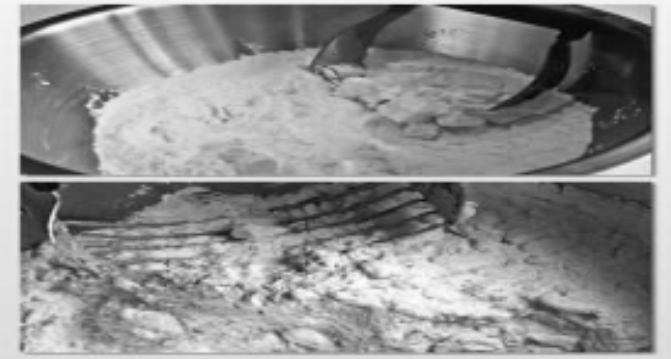
Melting Chocolate:
Put the chocolate into a heatproof bowl.
Select a saucepan during which the bowl will rest comfortably on top.
Fill the pan 1/3 full with water.
Heat the water over medium heat until steaming.
Place the bowl on top and make sure the bowl doesn’t touch the water.
As the chocolate softens, stir it with a wooden spoon until melted and smooth.
Use a pot holder or oven mitt and take care of the hot steam.

Whipping:
Using an electric mixer on low speed, beat the cream.
Increase the speed to medium-high until the cream thickens (about 3 minutes).
Turn off the mixer and lift the beaters. The cream is prepared if it stands in medium-firm peaks.
Be careful not to overbeat the cream too long.
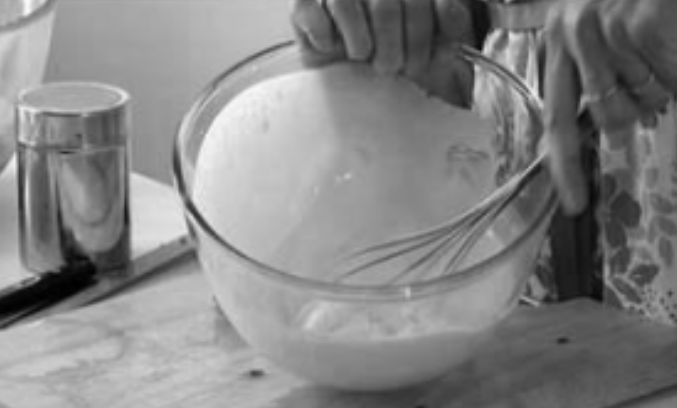
Cut and Fold:
To mix gently by bringing rubber scraper down through mixture.

— Tools & Equipment in Baking
Flour Sifter (Sieve) — An essential piece of equipment if flour is measured by cup rather than by weight.
Sifting flour insure accurate measurement.
Rubber (Pliable Plastic) Scraper - Useful for baking used to remove all sticky ingredients from measuring cups, scrape down the sides of a bowl, and get batter into baking pans.
Types of Measuring Cups:
Graduated or Liquid Cup
Individualized Dry Measuring Cups
Come in the series of cups indication functional fractional parts.
Commonly used for measuring flour.
Measuring Spoons — Set of individuals measuring spoons (tablespoon, teaspoon, 1⁄2 tablespoon, 1⁄4 teaspoon) and is necessary for small quantities of ingredients.
To use a measuring spoon properly, it should be filled until it is heaping full then levelled off with a spatula.
Mixing Bowl - Large enough to allow easy mixing and for rising in the case of yeast breads.
The most convenient mixing bowl is the one that has sloping sides rounding down to the bottom.
Dietetic Scale - An instrument used to measure the weight of the items or ingredients.
Electric Mixer — A motor-powered device used to stir and blend.
Rotary Egg Beater — A hand-held device for beating eggs, cream, and other liquids.
Wooden Spoon - Usually made of wood and comes in a variety of shapes and sizes a tool used for mixing and stirring flour mixtures.
Baking Pan - an aluminum or tempered glass dish, rectangular or square in form used for baking
Weighing Scale - Used to measure large quantities of ingredients. For baking purposes, a Dietetic or Spring Form Scale, where small quantities of ingredients are weighed.
Using an Oven Thermometer:
Most oven temperatures vary from top to bottom and side to sideac
Place an oven thermometer next to food while cooking to ensure proper temperatures.
Timer - monitors the baking time and rising of yeast.
Candy Thermometer - used to measure temperature of boiled sugar especially pulled sugar.
— Cutting Tools
Chef or French Knives — All-purpose knives used for a variety of chopping, slicing and mincing tasks.
Bread Knife — Usually has a serrated edge which helps cut bread or cake without crushing it. 3.
Kitchen Shears — Used for cutting dried fruits and vegetables fresh herbs and cutting pastry.
Grater and Shredder — Used to grate food, shred or slice vegetables, fruits and cheese into finer form.
Cookie Cutter — used to stamp out individual cookies from rolled dough. They are made of thin sheet metal or plastic that has been molded or formed into shapes. The cutting edges must be even and sharp enough to slice into the dough cleanly.
Biscuit and Dough Cutter - these are used to cut dough into desired shapes. These are often thought of as essential pieces equipment.
Miscellaneous Tools
Spatula - Comes in different sizes. A spatula with a blade of 5 to 6 inches long and about 1 inch wide suits many needs. Use small spatulas for removing muffins from pans or for speeding sandwich fillings. Larger spatulas are for griddlecakes for spreading frosting.
Rolling Pin - Although some bread may be made with-out a rolling pin some others are shaped more quickly and easily if a rolling pin is used. Dough for biscuit rolls, doughnuts, and coffeecakes can be patted using the palm of the hand. But if a rolling pin is used properly it will do the job faster and with better results.
Pastry Blender - this is used to cut biscuits, cones, piecrusts, and other kinds of dough.
Pastry Brush - Controls the quantity of glaze which is applied, and ensures that it is spread evenly and efficiently.
Pastry Wheel - used to cut strips of dough along with the blade.
Parchment Paper - a grease-resistant, non-stick, heatproof, quick- release coated paper used as lining baking pans and making piping cones for décor work.
Often reused until it becomes dark and brittle.
Wire Cooling Racks - Have feet that raise them above the counter so that moisture does not collect under cooling baked goods.
Can be used for glazing and confectionery works.
— Decorating Tools
Pastry Tip/Piping Tubes - plastic or metal tubes attached at the tip of the pastry bag to achieve the desired design when piping out icing.
— Kinds of Glaze, Icings, Frostings, & Fillings
Glaze - it is a glossy edible coating often sweet substance applied to food by dipping, dripping or with a brush. There are various glazes that you can choose from. They are as follows:
— Kinds of Glaze
Basic Milk Glaze - Can be made through whisking together 2 cups confectioner's sugar and 1/4 cup milk until smooth, add more milk if needed to reach desired consistency. Make about 3/4 cup.
Brown Sugar Glaze - Can be made by heating 6 tbsp. unsalted butter and 1⁄2 cup packed light brown sugar in a saucepan over medium, stirring until sugar has dissolved. Add 2 tbsp. of heavy cream, 1 tsp. vanilla extract and 1⁄2 tsp. salt and brings to a boil. When the mixture has thickened remove from heat and let cool. This makes about 1 cup.
Lemon Glaze – Made by whisking together 2 cups confectioner's sugar, 1⁄4 cup lemon juice and 2 tsp. grated lemon zest until smooth. This makes about 1 cup.
Chocolate Glaze - done by placing 3 ounces chopped bitter sweet chocolate in a heat proof bowl. In a saucepan heat 1⁄2 cup heavy cream and simmer, pour over chopped chocolate. Let stand for 2 minutes. Add 2 tbsp. unsalted butter, and mix until smooth. Stirring occasionally until slightly thickened. Makes 1 cup.
— Kinds of Icing/Frosting
Icing/Frosting - are sweet covering or coating in cakes and cake-related products. Usually the main ingredient is sugar, whether granulated or confectioners'.
Buttercream - Made by creaming butter until pale with icing sugar, vanilla and milk.
Ingredients:
125 g unsalted butter, softened
11⁄2 cups (240 g) powdered sugar, sifted
2 tablespoons milk
Procedure:
Beat butter in a small bowl using electric mixer until light and fluffy.
Gradually add half of the icing sugar, milk, then the rest of the remaining icing sugar.
Add flavour and colour as desired.
Fondant - Stiff and shiny icing can be kneaded and rolled out to cover fruit or chocolate mud cakes, often over a layer of marzipan.
Its firm consistency will help preserve the freshness of the cakes.
Often used to decorate bigger cakes and make it easy for transportation.
Meringue - Typically made from egg-whites, white sugar and water. This is whipped until fluffy then spread with a spatula onto cake to decorate creating a more beautifully looking products. Be reminded though, to do this quickly when icing your cake as it sets quickly after coming off the heat.
American-style Meringue Frosting Ingredients:
2 egg whites
425 g White sugar
100 mL water
Procedure:
Using a hand-held electric beater, whisk egg whites in the bowl over a saucepan of simmering water until very stiff.
In a separate pan, dissolve the sugar in water and boil for 5-10 minutes until the liquid is thick and syrupy and has reached the 'thread' stage - when the last few drops that fall from a spoon comes off in one long syrupy thread.
Pour the syrup over the egg whites, whisking all the time.
Return the bowl to above the saucepan of simmering water and continue to whisk for 10-15 minutes or until the icing is white, very thick and meringue-like.
Ganache - This is made through melting white or dark chocolate and cream. This can be looked shiny or matte and is used as a filling or piped to decorate pastry products.
Cream Cheese Icing - The combination of cream cheese, butter and icing sugar makes a delicious fluffy, cream-coloured icing. This is used traditionally used to decorate carrot cakes and cupcakes.
Royal Icing - Often confused with fondant, royal icing is a white meringue-like mixture made from egg whites, acetic acid and icing sugar.
Ideal for making flowers since this will become rock hard.
Boiled Icing - A light and fluffy cake icing made by gradually pouring a hot sugar syrup over stiffly beaten egg whites, beating constantly until the mixture is smooth and satiny.
— Kinds of Fillings Used for Pies and Pastries
Fillings — Cooked mixtures spread out in between slices of cakes and other related products. They are thick in consistency to make them easy to spread out.
Enhance the product and at the same time provide variation in flavour.
Jams and Jellies - Can be purchased ready-made and used as a filling alone or in combination with other fillings such as butter cream.
Meringue - This filling is made from beating egg whites with sugar. It can be used for covering pies. Can also be piped. It does not need refrigeration. It will become sticky when refrigerated.
Simple Sugar Syrup — Made from sugar and water, and then cooked. Can be flavoured which should complement the flavoured pastry. It is popular in presenting cream puff and éclair, it taste fresh and moist. Keep excess refrigerated.
Whipped Cream — Beaten with sugar until light and fluffy and can be flavoured. Can be stabilized for longer life with gelatine and can be used as a filling and frosting. Can be piped to form soft decorations. Must remain refrigerated.
— Accompaniments, Garnishes and Decorations for Pastries
Garnishing — Method of decorating food to make it more appealing thus enhancing once appetite.
Rules for Garnishing Pastry Products:
1. Garnishes should be edible.
2. Simplicity is beauty - Keep your garnishes simple and should appear natural, fresh and dainty -
3. A few small groups of garnish are often more attractive than a continuous decorative scheme.
4. The colors should be harmonized - never clash. Contrasting colors usually produce an artistic picture. If applying artificial coloring it should be kept to the minimum.
5. Avoid garnishes which are highly seasoned because they might affect the true taste of the main product.
6. Garnishes need not be expensive.
7. The garnish should not clash with the whole setting.
Syrup - flavoured simple syrup is used to moisten some pastries. Flavourings may be extracts like vanilla, liquors like rum.
Pastry Cream - this mixture contains starch thickeners as well as eggs, resulting in a much thicker and more stable product. This can be used as filling for any pastry and as pudding. If added with small amount of liquid, it can be used as sauce for custard.
Custards - consist of milk, sugar, eggs, and flavorings. If whole eggs are used as thickener it is thicker in consistency. Can be used to fill any pastry and as a dessert itself.
Nut Garnish - these are dry fruits or seeds used as decoration to any food.
Standards and Principles to be followed in Decorating and Finishing Pastry Products:
Color of the Product - Color should harmonize with the product since it stimulates sense of sight and enhanced once appetite. It is important that the presentation and plating must be eye-catching.
Appearance - is about form and shape after baking the product. Each piece or slice should have the same size, shape and form.
Consistency -it is the uniformity of grains and texture and how it feels in the mouth when eating the product.
Moisture Content - this refers to the amount of moisture that is present to the product. Moistness also enhances flavour and palatability.
Storing Baked Pies and Pastries
1. For open-faced pies. Cover the filling loosely with waxed paper.
2. For pies with a lattice-top crust. Cover only the cut openings on the two sides with plastic wrap.
3. Custard pies. These must be stored refrigerated as they easily absorb odors, but cannot be covered with plastic wrap without marring the surface. Store them into a large inverted bowl.
4. Pies with a top crust. To freeze pies or tarts with top crust with a firm topping, wrap before freezing.
5. Other pies or tarts should be frozen solid (3hrs in the freezer) before wrapping. Use Saran plastic wrap, which is airtight to wrap the pie or tart. Then slip into a reclosable 2-gallon freezer bag, expelling as much air as possible before sealing it.
6. Pies with meringue toppings should not be frozen.
Pies and Pastries Shelf Life
Refrigerator
Toaster Pastries
Freezer 2-3 months
Poultry Pastries
2-3 days
2-3 months
Fruit Pies, baked
2-3 days
8 months
Pies and Pastries,
2-3 days
3 months
cream filled
Pastries, baked
Pies and Pastries,
unbaked
--
3 days
1-2 months
4-6 months